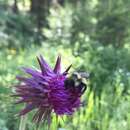en
names in breadcrumbs


Bombus insularis is a species of bumblebee in the subgenus Psithyrus, the cuckoo bumblebees. It is native to northern and western North America, where it occurs throughout Canada, Alaska, the northern United States, and some western states. It is known commonly as the indiscriminate cuckoo bumblebee.[1][2]
The female of the species is 1.6 to 1.9 centimeters long and just under a centimeter wide. The head is black with tufts of yellow hairs and the thorax is coated in long pale yellow hairs. The legs are hairy black. The abdomen has is black with yellow along the sides. The male is smaller, about half a centimeter wide at the abdomen. The head has long black hairs with small patches of yellow and the abdomen has strips of yellow and black hairs.[3]
This species lives in tundra and taiga, western mountain ranges, and some maritime regions.[1]
As in other cuckoo bees, the queen of this species enters the nest of a host species, kills the resident queen, and lives and breeds in the nest tended by the host workers. Host species of this bee include the white-shouldered bumblebee (B. appositus), yellow bumblebee (B. fervidus), yellow-fronted bumblebee (B. flavifrons), Nevada bumblebee (B. nevadensis), and orange-belted bumblebee (B. ternarius).[1]
This bee is still common and widespread, though it has declined in some areas and disappeared from a few parts of its historical range. Some of its host species have faced more significant declines. Potential threats include habitat loss, pesticides, pathogens from domesticated pollinators, competition from introduced bees, and climate change.[1]
Bombus insularis is a species of bumblebee in the subgenus Psithyrus, the cuckoo bumblebees. It is native to northern and western North America, where it occurs throughout Canada, Alaska, the northern United States, and some western states. It is known commonly as the indiscriminate cuckoo bumblebee.
The female of the species is 1.6 to 1.9 centimeters long and just under a centimeter wide. The head is black with tufts of yellow hairs and the thorax is coated in long pale yellow hairs. The legs are hairy black. The abdomen has is black with yellow along the sides. The male is smaller, about half a centimeter wide at the abdomen. The head has long black hairs with small patches of yellow and the abdomen has strips of yellow and black hairs.
This species lives in tundra and taiga, western mountain ranges, and some maritime regions.
As in other cuckoo bees, the queen of this species enters the nest of a host species, kills the resident queen, and lives and breeds in the nest tended by the host workers. Host species of this bee include the white-shouldered bumblebee (B. appositus), yellow bumblebee (B. fervidus), yellow-fronted bumblebee (B. flavifrons), Nevada bumblebee (B. nevadensis), and orange-belted bumblebee (B. ternarius).
This bee is still common and widespread, though it has declined in some areas and disappeared from a few parts of its historical range. Some of its host species have faced more significant declines. Potential threats include habitat loss, pesticides, pathogens from domesticated pollinators, competition from introduced bees, and climate change.
Bombus insularis is een vliesvleugelig insect uit de familie bijen en hommels (Apidae). De wetenschappelijke naam van de soort is voor het eerst geldig gepubliceerd in 1861 door Smith.[1]
Bronnen, noten en/of referentiesBombus insularis (saknar svenskt namn) är en insekt i överfamiljen bin (Apoidea) och släktet humlor (Bombus).
Arten förekommer sällsynt i östa USA från Michigan, Wisconsin, New York, New England och till nordöstligaste Pennsylvania.[2]
En förhållandevis liten humla; drottningen är 16–19 millimeter lång och hanarna 13–16 millimeter.
Drottningen har svart huvud med gula hår mellan antennerna och längs mittlinjen. Mellankroppen är ljusgul utom på undersidan och det centrala, bakre partiet. De två första bakkroppslederna kraftigt svarthåriga, följt av två leder som är gulhåriga på sidorna men svarthåriga för övrigt. Den femte bakkroppsleden är svarthårig med några få gula strån, medan bakkroppsspetsen är hårlös och svart. Mundelarna är kraftigare än hanens.
Hanens huvud liknar drottningens, men det gula partiet är mindre än hos henne. Större delen av mellankroppens översida är gulhårig, resten (framför allt undersidan och delar av mellankroppens bakre del) är svarthårig. De fyra första bakkroppssegmenten är kraftigt gulhåriga, resten av bakkroppen är svarthårig. Dock kan sidornas mittparti ha en del gula hår.[3] Tungan är kort[2].
Humlan är en snylthumla, och honan lever som boparasit hos andra humlor, som arterna Bombus flavifrons,[3] Bombus pensylvanicus, Bombus rufocinctus, Bombus ternarius och Bombus terricola[2]. Den flyger till blommande växter som gullris, sötväpplingar, blåbärssläktet och klöversläktet.[2]
Bombus insularis (saknar svenskt namn) är en insekt i överfamiljen bin (Apoidea) och släktet humlor (Bombus).
Bombus insularis là một loài Hymenoptera trong họ Apidae. Loài này được Smith mô tả khoa học năm 1861.[2]
Bombus insularis là một loài Hymenoptera trong họ Apidae. Loài này được Smith mô tả khoa học năm 1861.